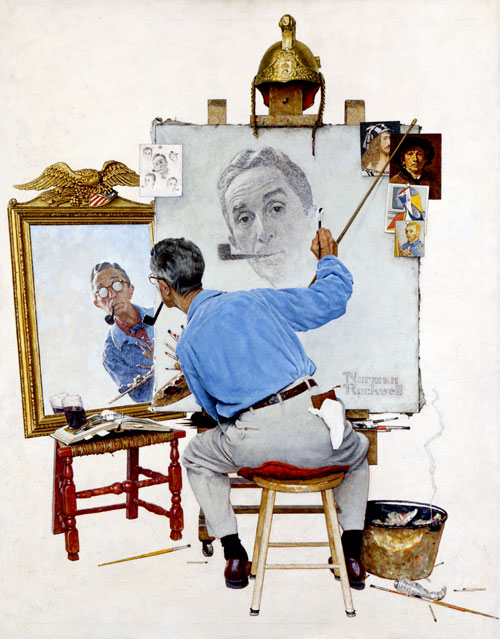

Triple Self-Portrait, 1960
Humor and humility were essential aspects of Norman Rockwell's character, so when asked to do a self-portrait that would announce the first of eight excerpts of his autobiography, the results were lighthearted and somewhat self-deprecating.
Rockwell was a stickler for neatness, but here he has scattered matchsticks, paint tubes, and brushes over the studio floor. The glass of Coca-Cola, Rockwell's usual afternoon pick-me-up, looks as if it will tip over at any moment. Other discrepancies can be explained away. He has traded his usual Windsor chair for a stool (easier to see more of him?) and his milk glass palette table for a hand-held wooden palette (an economy of picture space?) Most of the features are real: He did tack or tape studies to his drawings or canvases and he did immerse himself in favorite artwork before beginning a project.
As Rockwell's assistant, Louie Lamone, recalls, paint rags and pipe ashes sometimes conspired to ignite small fires in Rockwell's brass bucket, so the wisp of smoke in the painting rings true. Rockwell's brass helmet, usually placed on an unused easel, crowns this one. Just as the smoke is a reminder that once Rockwell's studio caught fire as a result of his carelessness with pipe ashes, the helmet reminds us of a favorite Rockwell story. While in Paris in 1923, Rockwell acquired it from an antiques dealer who sold it as a military relic rather than as the contemporary French fireman's helmet Rockwell later found it to be.
The four self-portraits on his canvas - Albrecht Durer, Rembrandt van Rijn, Pablo Picasso, and Vincent Van Gogh - are his references. They invite us to compare (as he did) how other artists tackled the problem of a self-portrait. Unlike Rockwell, all four artists produced numerous formal self-portraits-Rembrandt is known to have done more than 90. Rockwell produced only two other full-color self-portraits: Norman Rockwell Painting the Soda Jerk, showing the artist from the waist up at work on his 1953 Post cover, and The Deadline, a 1938 Post cover composed much the same as this one-the rear view of the artist at work at his easel. Both are unselfconscious portraits, confirming that in 1953 and 1960 Rockwell's view of himself continued unchanged.
Triple Self-Portrait, Norman Rockwell, 1960.
Oil on canvas, 44½" x 34¾"
Cover illustration for The Saturday Evening Post, February 13, 1960.
From the permanent collection of Norman Rockwell Museum.
Triple Self-Portrait (study), Norman Rockwell, 1960.
Reference photos for Triple Self-Portrait by Clemens Kalisher, 1960.